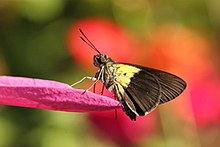Quedara basiflava
| Golden flitter | |
|---|---|

| |
| Scientific classification | |
| Domain: | Eukaryota |
| Kingdom: | Animalia |
| Phylum: | Arthropoda |
| Class: | Insecta |
| Order: | Lepidoptera |
| Family: | Hesperiidae |
| Genus: | Quedara |
| Species: | Q. basiflava
|
| Binomial name | |
| Quedara basiflava (de Nicéville, 1888)
| |
Quedara basiflava, the yellow-base flitter
Description
Male. Upperside dark glossy blackish-brown, almost black. Forewing with a short post-medial semi-hyaline, white, fairly broad band, composed of two semi-quadrate, rather long, conjugated spots, filling up the end of the cell, the lower spot the larger, a still larger semi-quadrate spot below extending to the first median nervule, only divided from the upper spots by the median vein, its outer end extending somewhat outwards. Hindwing without markings. Cilia of both wings brown. Underside almost as dark as the upperside. Forewing with markings similar. Hindwing with a chrome-yellow basal patch, varying in extent in different examples, in the type specimen the basal third of the wing is so coloured, in some examples from the Nilgiris the chrome-yellow basal patch is much more limited. Antennae black, without markings; palpi, head and body above and the legs concolorous with the wings, palpi and thorax below greyish, abdomen cinereous. Female like the male, the spots on the forewing a little larger.
Food plants
The larvae feed on Calamus hookerianus, Calamus pseudofeanus, Calamus rotang and Calamus thwaitesii.[7][8]
References
- ^ Kunte, K. and K. Saji. 2013. Quedara basiflava de Nicéville, 1888 – Yellow-base Flitter. In K. Kunte, S. Kalesh & U. Kodandaramaiah (eds.). Butterflies of India, v. 1.06. Indian Foundation for Butterflies. [1]
- ^ ISBN 978-81-929826-4-9.
- ^ Markku Savela's website on Lepidoptera Page on genus Quedara.
- ^ E. Y., Watson (1891). Hesperiidae Indicae : being a reprint of descriptions of the Hesperiidae of India, Burma, and Ceylon. Madras: Vest and Company. p. 130.
- ^ W. H., Evans (1949). A Catalogue of the Hesperiidae from Europe, Asia, and Australia in the British Museum. London: British Museum (Natural History). Department of Entomology. p. 304.
- ^ a b
 One or more of the preceding sentences incorporates text from this source, which is in the public domain: Swinhoe, Charles (1912–1913). Lepidoptera Indica. Vol. X. Vol. 10. London: Lovell Reeve and Co. p. 203.
One or more of the preceding sentences incorporates text from this source, which is in the public domain: Swinhoe, Charles (1912–1913). Lepidoptera Indica. Vol. X. Vol. 10. London: Lovell Reeve and Co. p. 203.
- .
- ^ K. Kunte (2006). "Additions to the known larval host plants of Indian butterflies". Journal of the Bombay Natural History Society. 103 (1): 119–121.
